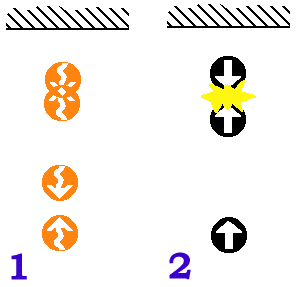Idle musings on reflection. The electric congaPreviously I was musing over what happens when particles with inertia were chained together. I want to explore that a bit further in the context of everyday reflection.
We know that photons behave as the sea waves and we know that electrons behave like the ping-pong balls. The crucial difference is that successive photons don't interact but successive electrons do ‘know each other is there'. If the front electron in an electric conga stops suddenly then all the others bump into it. If a stream of electrons is like the bicycle-chain structures I was considering in another musing then I think something different happens when being reflected than when a stream of photons is reflected.
Notice how with a particle system there is an energy exchange (kinetic-potential-kinetic) during the reflection. This must take some finite amount of time, and the perpendicular component of velocity must go through zero. The lateral component VL of velocity is constant. For mathematical purposes we can extend the incoming path and the outgoing path to meet at a vertex A but the particle will never reach that vertex as it has to ‘cut the corner' because it is slowed down and to cover the distance in the time demanded by the lateral velocity component it can't get all the way there. Getting the energy transferred in the time available must be a limiting factor. I'd like to know more. My suspicion is that in any reflection there must be energy transfer and that must take time.
So what I would like to play with is a model where a ‘bicycle chain' slides up a friction free surface to be reflected. I'm sure it will behave differently from the independent ball bearings, but how, what the limiting parameters are and the extent of the differences I can't say. But surely there is no such thing as a train of electrons that can be anything like as close enough to affect each other? Don't know, don't care - It's the wrong question to ask ‘cos we don't know what the parameters are yet. But let us assume for a moment that a typical cathode ray gun is shooting electrical bullets which are to all intents and purposes ignorant of each other. What about electrons in atomic shells or nuclei? These guys are variously holding positions relative to others so certainly come in this scope. When does an incident photon reflect, refract or become absorbed? This matter has been extensively studied in the long tradition of optics. It would be nice to relate things like the Brewster angle to the struggle to turn a particle around in a limited time or distance which I've just described. Interestingly we have a purely ‘non-contact' reflection method with electrostatic repulsion, except that at some stage we're going to fire such a fast electron towards our negative plate that it ‘hits'. What are the parameters that control the details of that limiting case. Time and energy are surely the keys. I'm also interested in looking at what happens when a doughnut slides up and down a slope? What happens if it is rotating? What happens if there are a small number of particles chained together? When a tennis ball (just a 3-D doughnut) is hit by a racquet energy exchange (kinetic-strain-kinetic) takes place in the ball as well as the wall. Try that with an egg and racquet or tennis ball and sand and the results are different. Try it with an alpha particle. Would somebody like to develop a mathematical model (with pretty visualisations) to investigate what happens when a conga of finite length encounters a repulsive field. |
©


